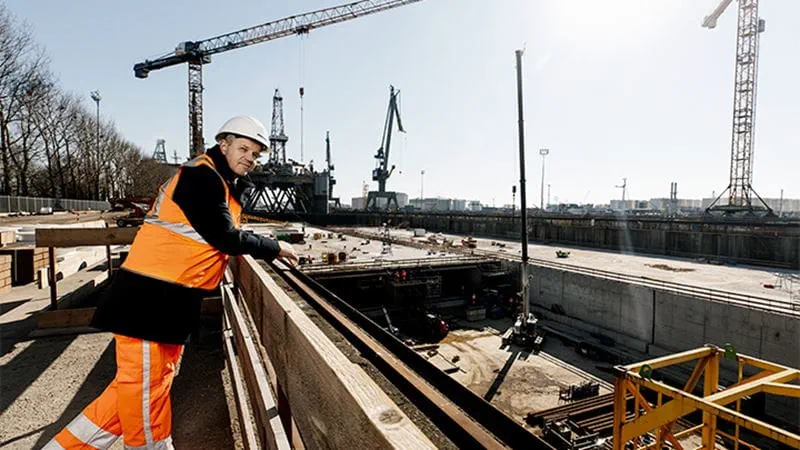Making the link

A massive infrastructure project is underway that will provide a new transport corridor to connect Scandinavia and Central Europe in a greener, quicker way. Once completed, the 18-kilometer Fehmarn Belt Fixed Link will be the world’s largest immersed tunnel. It is made up of sections built on land, that are floated and towed to the tunnel site, sunk into place and linked together.
The new tunnel will connect the Danish town of Rødbyhavn and the German island village of Puttgarden in an underwater journey through the Fehmarn Belt strait that will take just seven minutes by train and ten minutes by car.
The immersed tunnel will also provide a more direct route for international trains, trucks, and vehicles, dramatically shortening today’s 160-kilometer detour to cross the strait. It will also cut down on ferry traffic, with the tunnel’s road and train passengers saving about an hour on the crossing. As a result, the new link will contribute to a reduction in CO2 emissions.
Construction of the tunnel, which takes place on land and as deep as 50 meters undersea, began in 2020. In 2021, both Germany and Denmark began constructing the tunnel portals. The project involves hundreds of sub-contractors and thousands of workers. Trelleborg has a contract with Femern Link Contractors (FLC) and is the sole supplier of sealing solutions.
Connecting Denmark and Germany underwater is no easy feat and requires a massive number of components and materials. For instance, an entire manufacturing facility was built just to produce the concrete for the tunnel.
Trelleborg, which has played a role in many other immersed tunnel projects, understands the challenges that come with such infrastructure. The company will supply its waterstops for waterproof tunnel elements, portals and ramps, as well as 89 Gina gaskets and 89 Omega seals for the permanent immersion joints that connect the tunnel elements. All of these solutions mean the tunnel will be able to withstand movement, while also remaining waterproof.
Every immersed tunnel project comes with its own set of challenges and the Fehmarnbelt project is no exception. Trelleborg Design Engineer, Nicas van den Brink, says the soil type and sea depth in the area require tailormade solutions.
“Part of the tunnel is built on loose Paleogene clay, which means we have to accommodate more ground movement and shifts without leakage. We are providing the largest immersible Gina gaskets ever produced, and our design must withstand water pressure at the deepest point of the tunnel, as well as expand in summer and retract in winter,” he says.
“We have also developed and patented a waterstop with a new injection system for the client to cope with the dynamic behavior of the structure. And, to receive approval for this project, mitigating measures were taken not to affect the existing natural ecosystem.”
The Fehmarnbelt tunnel is a highprofile project that will take many years to complete. Trelleborg is providing a dedicated support team and on-site personnel throughout the entire project lifecycle to ensure on-time and on-budget delivery: from consultation, engineering design and full-scale testing to aftersales service.
“We have a tight building schedule and can’t afford any delay,” says Rene Fredriks, Managing Director for infrastructure solutions at Trelleborg, adding that the Gina gaskets and Omega seals will be produced in multiple locations to ensure continuity of supply. “We are extremely proud to be part of such a prestigious project. It’s the biggest and most elaborate infrastructure project for Trelleborg,” he says.
World’s longest immersed tunnel
What? Fehmarnbelt Fixed Link tunnel is an 18-kilometer-long immersed tunnel.
Where? It will connect the Danish island of Lolland with the German island of Fehmarn, crossing the Fehmarn Belt in the Baltic Sea.
Why? The tunnel will reduce travel time by car from 45 minutes to seven minutes compared with traveling by ferry and will reduce CO2 emissions by offering a more direct transportation route.
When? Expected to be complete in 2029.
To find out please visit:
Press Service:
If you reproduce information from this release please give contact details as:
www.trelleborg.com
E-mail: news@trelleborg.com